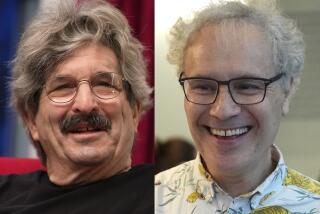‘Suicide Cell’ Work Earns Trio a Nobel
A La Jolla scientist and two colleagues from MIT and Cambridge University who used the simple roundworm to unravel the complex processes controlling the birth and death of cells in humans on Monday received the 2002 Nobel Prize in physiology or medicine.
Working separately, the two Britons and an American discovered how living organisms dispose of cells they no longer need, a process that is crucial in shaping the brain, for example, and that may ultimately provide ways to fight cancer and other diseases.
British biologist Sydney Brenner, 75, of the Salk Institute for Biological Sciences in La Jolla, biologist John E. Sulston, 60, who is retired from Cambridge University’s Sanger Centre, and molecular biologist H. Robert Horvitz, 55, of the Massachusetts Institute of Technology will share the prize, worth nearly $1 million.
The three showed for the first time that each cell carries suicide instructions within its own DNA blueprint, allowing it to self-destruct when the body no longer needs it. Subsequent work has demonstrated that failures in following these instructions lead to many types of diseases.
Cancer, for example, represents a failure of cells to die when they are proliferating uncontrollably, while Alzheimer’s and similar diseases are caused by the premature death of crucial cells in the brain. The three laureates’ work has opened the door to new ways to combat both types of failures.
Their discoveries “are important for medical research and have shed new light on the pathogenesis of many diseases,” the Nobel Assembly in Sweden said in the award citation.
Horvitz learned of the win while vacationing in the Alps. “It was quite enjoyable to have champagne before lunch in France,” he said in a telephone news conference. “I would find nothing more gratifying than to learn that one or more of my discoveries led specifically to pharmaceutical treatments and cures for human diseases.”
Sulston, who retired from the Sanger Centre in 2000, said he was “surprised and obviously delighted.” He minimized his own contributions, but noted that “clearly it has been the foundation for a great deal more, and that’s extremely delightful.”
Brenner was in Munich, Germany, on Monday and made no statement to the media.
His prize “was well overdue,” said molecular biologist Francis Crick of the Salk Institute, who worked with Brenner in England in the 1950s and 1960s. “If a Nobel Prize were given for an outstanding body of work, Sydney would almost certainly have been awarded one years ago.”
“Sydney was often referred to as ‘the brightest person not to have won a Nobel Prize,’ ” neurobiologist Greg Lemke of Salk added. “With today’s news, he no longer holds this distinction.”
Brenner played a crucial role in the 1960s in developing our understanding of how DNA and genes work. Once that problem was solved, his interests turned to issues of development--how an organism grows from a single-cell egg to a multicellular organism. His key insight was recognizing that researchers in the field needed their own “laboratory rat,” something simpler than the fruit fly but more complicated than bacteria and protozoa.
After several years, he concentrated on nematodes, a family of tiny, ubiquitous worms. His ultimate choice was Caenorhabditis elegans, a transparent nematode 1 millimeter long--about the size of Lincoln’s nose on a penny.
Brenner “broke new ground” in 1974, according to the Nobel Assembly, when he demonstrated that specific gene mutations could be induced in C. elegans and linked to specific structural mutations in organs that could be seen under a microscope.
His work “laid the foundation” for everything that has subsequently been achieved in the field, the citation says.
Sulston mapped the individual cells of the nematode as it grew from a fertilized egg to an adult. He found that the egg produced 1,090 cells, but that 131 were pruned during the course of development, leaving only 959 cells in an adult.
He eventually demonstrated that the fate of each cell was determined at its birth and that the same cells are killed as every nematode matures. Under the microscope, he said Monday, “we could actually see programmed cell death in action, so beautiful, so clear and so reproducible.”
He also demonstrated the first mutations of the genes participating in this programmed cell death, which is called apoptosis.
Horvitz studied this process on the molecular level and identified the first two bona fide “death genes,” called ced-3 and ced-4. In the mid-1980s, he demonstrated that functional copies of ced-3 and ced-4 were necessary for programmed cell death to occur.
Later, he showed that another gene, called ced-9, protects against cellular death by interacting with the first two genes. He has subsequently found other genes that direct how the dead cells are eliminated.
Researchers now know that most of these genes identified in C. elegans have human counterparts. Ced-9, for example, is similar to a human gene called Bcl-2 that is important in the development of B-cell follicular lymphoma, a type of leukemia.
Many companies and academic laboratories are searching for ways to manipulate these genes. A drug that could induce apoptosis in cancer cells, for example, would theoretically have far fewer side effects than currently used chemotherapy agents.
And drugs that block apoptosis might prevent brain deterioration in Alzheimer’s and Parkinson’s.






